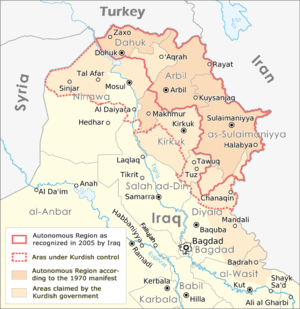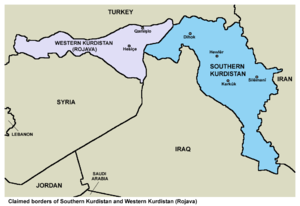Disputed territories of Northern Iraq

The disputed territories of Northern Iraq are regions defined by article 140 of the Constitution of Iraq as being Arabised during the Baath Party rule in Iraq. Most of these regions had previously been inhabited by non-Arabs, most notably Kurds, and were later Arabised by transferring and settling Arab tribes in the areas.
The disputed areas have been a core concern for Arabs and Kurds, especially since the US invasion and political restructuring in 2003. Kurds gained territory to the south of Iraqi Kurdistan after the US-led invasion in 2003 to regain what land they considered historically theirs.[1]
Currently, in addition to the three governorates of Iraqi Kurdistan, Kurds control parts of Nineveh Governorate, Kirkuk Governorate, Salah ad Din Governorate and Diyala Governorate; on the other hand, Iraqi government controls parts of those four provinces, some parts of which are also claimed by the Kurds. However, during the 2014 ISIL offensive, Iraqi Kurdistan's forces also took over much of the disputed territories.
Tensions between Iraq and Iraqi Kurdistan in 2012

Tensions between Iraqi Kurdistan and the central Iraqi government mounted through 2011–2012 on the issues of power sharing, oil production and territorial control. In April 2012, Masoud Barzani, president of the semi-autonomous Iraqi Kurdistan, demanded that officials agree to their demands or face a secession from Baghdad by September 2012.[2]
In September 2012, the Iraqi government ordered the Kurdistan Regional Government (KRG) to transfer its powers over Peshmerga to the central government and relations were strained further by the formation of a new command center (Tigris Operation Command) for Iraqi forces to operate in a disputed area over which both Baghdad and the KRG claim jurisdiction.[3]
On 16 November 2012, a military clash between the Iraqi forces and the Peshmerga resulted in one person killed.[3] CNN reported that 2 people were killed (one of them an Iraqi soldier) and 10 wounded in clashes at the Tuz Khurmato town.[4]
On the night of November 19, clashes between security forces of the central Iraqi government and the KRG forces in Tigrit left 12 Iraqi soldiers and one civilian dead, according to Doğan news agency.[5] The clash erupted when Iraqi soldiers attempted to enter northern Iraq; peshmargas tried to prevent the Iraqi soldiers from entering the area upon Barzani’s instructions.[5] On November 25, it was reported that Iraqi Kurdistan sent reinforcements to a disputed area where its troops are involved in a standoff with the Iraqi army, despite calls on both sides for dialogue to calm the situation.[6]
Territories included

The Committee for implementing article 140 defines the disputed territories as those areas Arabised and whose border modified between 17 July 1968 and 9 April 2003. Those areas include parts of four governorates of pre-1968 borders.[7]
One of the major problems in trying to implement Article 140 was a discrepancy in the definition of 'disputed area'.[1] The article only refers to regions that would go through this normalization process as "Kirkuk and other disputed area".[1] In 2003, Kurdish negotiator Mahmud Othman suggested that Kurdish majority areas below the Green line be attached to the KRG immediately, and 'mixed areas' should be questioned on a case-by-case basis.[1] Sunnis felt as if Kurds should gain no additional land as a result of the US invasion.[1] Reattaching Kirkuk districts to reflect the 1975 boundaries posed many problems to Iraqis and brought along unintended consequences.[1]
Nineveh Governorate
Includes Aqra District and the northern part of Al-Shikhan District, which have been under Kurdish control since 1991, and the three districts of the Nineveh plains of Assyrian, Yazidi and Shabak population as well as Sinjar town and Tel Afar District of mixed Arab and Yazidi population. Sinjar District and northern parts of Tel Afar District and Nineveh plains is currently under the control of Iraqi Kurdistan.
Arbil Governorate
The disputed territories include the Makhmur District which has been separated from the rest of the governorate since 1991. Makhmur District is currently under the control of Iraqi Kurdistan.
Kirkuk Governorate
Kirkuk Governorate is defined by its pre-1968 borders, including Chamchamal and Kalar districts of Sulaymaniyah Governorate and Tooz District of Salah ad Din and Kifri District of Diyala.
Kirkuk province borders were altered, the Kurdish dominated districts were added to Erbil and Sulamaniya provinces. the Arab districts were added to Kirkuk province. Turkmen villages were added to Diyala and Salahuddin provinces.[8] On 12 June 2014, all of Kirkuk Governorate was taken by Kurdish forces when Iraqi army fled following the success of the ISIL 2014 Northern Iraq offensive. Kirkuk Governorate is currently under the control of Iraqi Kurdistan.
| Census results for Kirkuk Governorate[9] | |||||||
| Mother tongue | 1957 | Percentage | 1977 | Percentage | 1997 | Percentage | |
|---|---|---|---|---|---|---|---|
| Kurds | 187,593 | 48.2% | 184,875 | 38% | 155,861 | 21% | |
| Arabs | 109,620 | 28.2% | 218,755 | 45% | 544,596 | 72% | |
| Turkmens | 83,371 | 21.4% | 80,347 | 17% | 50,099 | 7% | |
| Assyrians | 1,605 | 0.4% | |||||
| Jews | 123 | 0.03% | |||||
| Other | 6,545 | 1.77% | 0 | 0% | 2,189 | 0.3% | |
| Total | 388,829 | 100% | 483,977 | 100% | 752,745 | 100% | |
Diyala and other governorates
Disputed territories include Khanaqin, Kifri and Baladrooz districts of Diyala Governorate, Tooz District which is currently part of Salah ad Din Governorate, and Badra District which is currently part of Wasit Governorate. Khanaqin District, Kifri District and Tooz District which is currently under the control of Iraqi Kurdistan.
See also
References
- 1 2 3 4 5 6 Bartu, Peter (2010). "Wrestling With the Integrity of A Nation: The Disputed Internal Boundaries in Iraq". International Affairs. 6. 86.
- ↑ "Iraqi Kurd leader threatens secession unless power share demands met". Al Arabiya News. 26 April 2012. Retrieved 15 August 2016.
- 1 2 Coles, Isabel (18 November 2012). "Iraqi Kurdish leader says region will defend itself". Reuters. Retrieved 1 May 2016.
- ↑ Tawfeeq, Mohammed (16 November 2012). "Two dead, 10 wounded after Iraqi, Kurdish forces clash in northern Iraq". CNN. Retrieved 1 May 2016.
- 1 2 Akan, Selim (21 November 2012). "Iraq tensions added to regional turmoil". Hürriyet Daily News. Retrieved 1 May 2016.
- ↑ "Iraqi Kurdistan send more troops into standoff with Iraq Arab-led army". Ekurd Daily. 25 November 2012. Retrieved 1 May 2016.
- ↑ نبذة عن لجنة تنفيذ المادة (140) من دستور جمهورية العراق (Arabic)
- ↑ Dagher, Sam (25 April 2008). "Can the U.N. avert a Kirkuk border war?". Christian Science Monitor. Retrieved August 2, 2012.
- ↑ Anderson, Liam D.; Stansfield, Gareth R. V. (2009), Crisis in Kirkuk: The Ethnopolitics of Conflict and Compromise, University of Pennsylvania Press, p. 43, ISBN 0-8122-4176-2